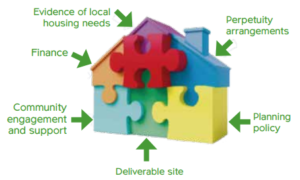Supply of rural affordable housing – how can this be improved
How can rural affordable housing supply be improved?

The need for rural affordable housing is well understood and the consequences of its absence, for low-income families and the very sustainability of rural communities, have been well rehearsed.
Yet there remains a shortage. New rural affordable housing is still a rarity rather than the norm. Nationally, CPRE, the countryside charity, has long championed the delivery of affordable housing, particularly through its policy-influencing work.
However, at the local level, CPRE groups and individual members have often struggled to find ways in which they can actively and positively support its delivery.
With increasing awareness of the problem and recognition of the high quality of rural affordable homes and the benefits they can bring, there is a growing appetite to do more at local level. Outwardly, providing rural affordable housing looks simple: find a site, secure finance, gain community support and build it.
It sounds so straightforward, but behind each of these interrelated components are an array of technical details that can, on closer inspection, make it seem overwhelmingly complex. Initially, this may leave you feeling daunted and perhaps put you off doing anything, when all you want to do is to build some much-needed rural affordable housing.
To deliver a successful rural affordable scheme, six components need to be in place. These apply whether the scheme is built as part of a market-led development or on a rural exception site.
Finance: All development needs finance to cover the costs of build, but the income from affordable homes will never be enough on its own to cover these and grant subsidy will be required.
This may be from a range of public sources or from surpluses made from the market housing once development costs have been covered. Community engagement and support the community may be the instigator of the development and will certainly have a say in whether it gains planning permission.
Their early and constructive engagement is vital to the development progressing smoothly, providing the type of affordable homes they need and resulting in a scheme they can be proud of. Perpetuity arrangements are already a scarcity of rural affordable housing and there are often only limited opportunities to provide it.
It is frequently dependent on landowners selling sites at a price well below full market value. Their willingness to do so, along with community support for a scheme, requires that the homes be retained as affordable housing in perpetuity and occupied by people with a housing need who have a connection with the community.
Bringing all these elements together is a responsibility shared across several organisations, from the local authority planning and housing enabling staff and the housing association or community-led housing organisation to the community itself.
Affordability refers to how much it costs an individual to buy or rent a home and whether this is judged to be affordable. The broadly accepted definitions of what is affordable, based on mortgage lending norms and research, are:
- Open market housing requires a mortgage lending ratio of no more than 3 times annual income for a single household and 2.5 times annual income for a two-person household.
- Rented housing requires that a household pays no more than 35% of their net income on rent. Affordable housing There is no statutory definition of affordable housing, but annexe 2 defines it as being housing for sale or rent for those whose needs are not met by the market and which complies with a provided list of defined tenures.
These include affordable homes for rent – including Affordable Rented housing, where the rent is 20% less than local market rents, and social rent, where the rent is set by government policy. In practice, social rent is usually lower than Affordable Rent.
Read more: What is affordable housing
